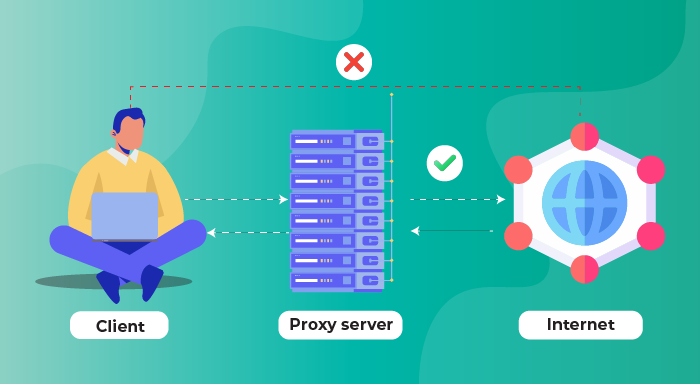Using more than one proxy server is a seemingly wild idea that could potentially increase your security and privacy. The only issue is that one network request cannot pass through multiple proxy servers without some tinkering.
Proxy Chaining is the only solution to this problem. In this article you will get to know about Proxy Chaining, What it is and why you need it?.
What Exactly is a Proxy Server?
A proxy acts as a middleman that can establish an internet connection on your behalf. When you use a proxy, the target server does not see your original IP address and thus cannot track you or determine your location. Only the information from the proxy server is visible, as it’s included in the final network request.
These requests are data packets like every other, except instead of sending data to load a service, they ask for data. Once the web server receives the request, it can send the data needed for loading a website, showing a video, running an app, etc.
Some proxies do not alter network requests and show to the target server that the initial requester is your device. These types of proxies are known as transparent proxies, but due to security and anonymity purposes they aren’t widely used. Most proxy applications, including proxy chains, use anonymous proxies.
Every proxy type, be it a datacenter, mobile, or residential proxy, can pass on network requests anonymously. That is, without telling the end server who the initial requester is. However, even if the proxy server is anonymous, websites can still know that it is a proxy and even figure out the initial requester.
Some proxy providers make mistakes when editing HTTP requests. Others use only IP addresses widely known as proxies. By choosing only a credible proxy provider these vulnerabilities can be solved.
Another method is for the target server to connect using common proxy ports. If the connection works, it means that a proxy server is used, and it may be possible to figure out the original requester. A skilled system admin can potentially uncover most proxies using such a method.
The best way to counter this for proxy users is to increase the amount of time and other resources needed to find the original IP. That’s where proxy chains come in.
Proxy Chains
Proxy chaining is a method of connecting two or more proxy servers to route network requests in turn. First is the initial proxy server, which hides your IP address and changes geo-location as usual. Second is the next proxy server, which receives the request from the previous proxy and passes it on.
The process could theoretically go on forever, adding more proxies in various locations and types. However, the more proxies there are in the chain, the longer your request will take to reach the target server and return it to you. Long proxy chains with slow proxies can make even simple tasks, such as browsing the web, take a very long time.
This drawback has mainly two reasons: Each proxy in the chain only knows the proxy server before and after it. There are other setups, but if proxy servers know the original request sender, it might make it easier for someone to unveil its identity.
Each step in a proxy chain can be described as a network hop. It’s an action a data packet, such as a request, takes when being sent from one network to another. The more network hops there are, the slower the connection.
Proxy chains could be made from IPs on the same network or even on the same devices that host them virtually, as in the case of datacenter proxies. However, it’s unclear how much more security this would bring as a potential attacker could figure out that every proxy is in the same network.
How can proxy chains be configured?
There are quite a few technicalities you need to know before configuring a proxy chain yourself. Luckily, there are software solutions, such as Proxifier, that can help you set up proxies without much coding knowledge.
Software of this type allows users to make any software run on proxies with a user-friendly UI. Proxy chains can also be configured by simply choosing the correct settings. However, there is one prerequisite you’ll need from your proxies.
All your proxies need to support port forwarding. It’s a networking function that allows the direct transition of communication from one port device port to another as if they were in one network. Proxy chains will not work without port forwarding or would work too slowly to be useful.
Why are proxy Chains beneficial?
With port forwarding and the correct setup of good-quality proxies, a small proxy chain will barely be slower than using one proxy server. But what exactly are the benefits of using proxy servers?
Increased Security. Many attacks, such as Man in the Middle, rely on the perpetrator taking over the communications or figuring out the identities of the parties involved. With proxy chains, such attacks are much more difficult to pull off.
Increased anonymity. In most cases, one proxy server is enough, but some target servers are known to try to locate the original IPs. With proxy chains, their scripts will need much more computing power and might not make it in time before you switch to another proxy.
Performance. In some cases, the speed of web browsing or other tasks might actually increase with a proxy chain. If quality proxies are used and set up correctly, they may increase the caching capabilities, which lets you access frequently visited services faster.
It’s important to note that these benefits come with an optimal proxy chain setup, which is difficult to achieve.
Final Words
While proxy chaining is very beneficial on paper, it requires some advanced knowledge of programming, additional software, and many high-quality proxies. It’s not for ordinary use cases, such as anonymous browsing. However, if you really need that extra layer of security, the option is there.
Related Posts





0 Comments